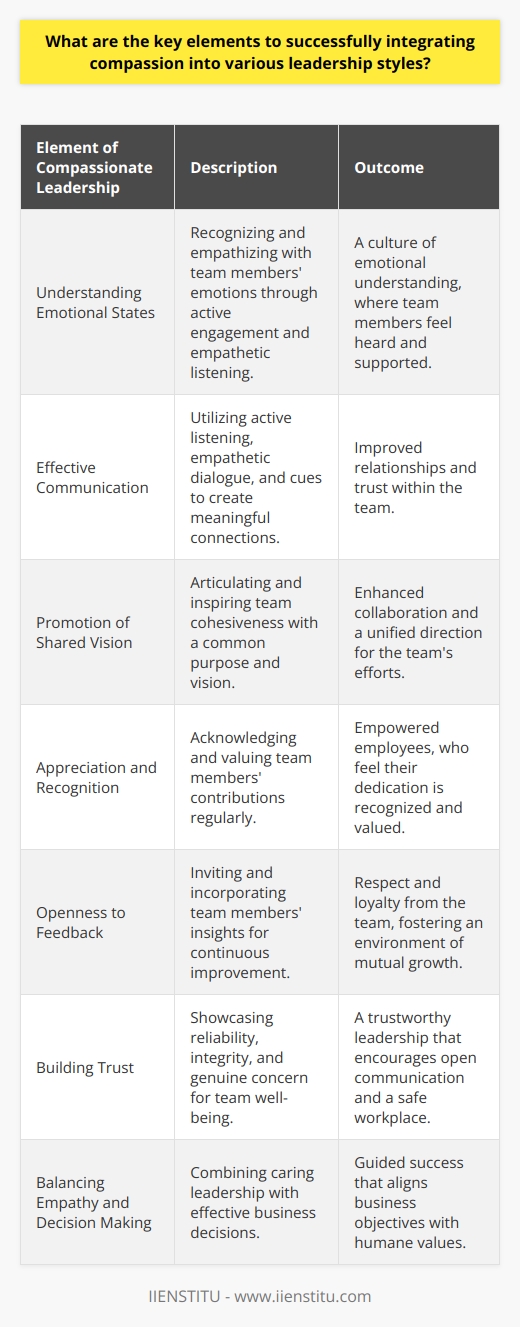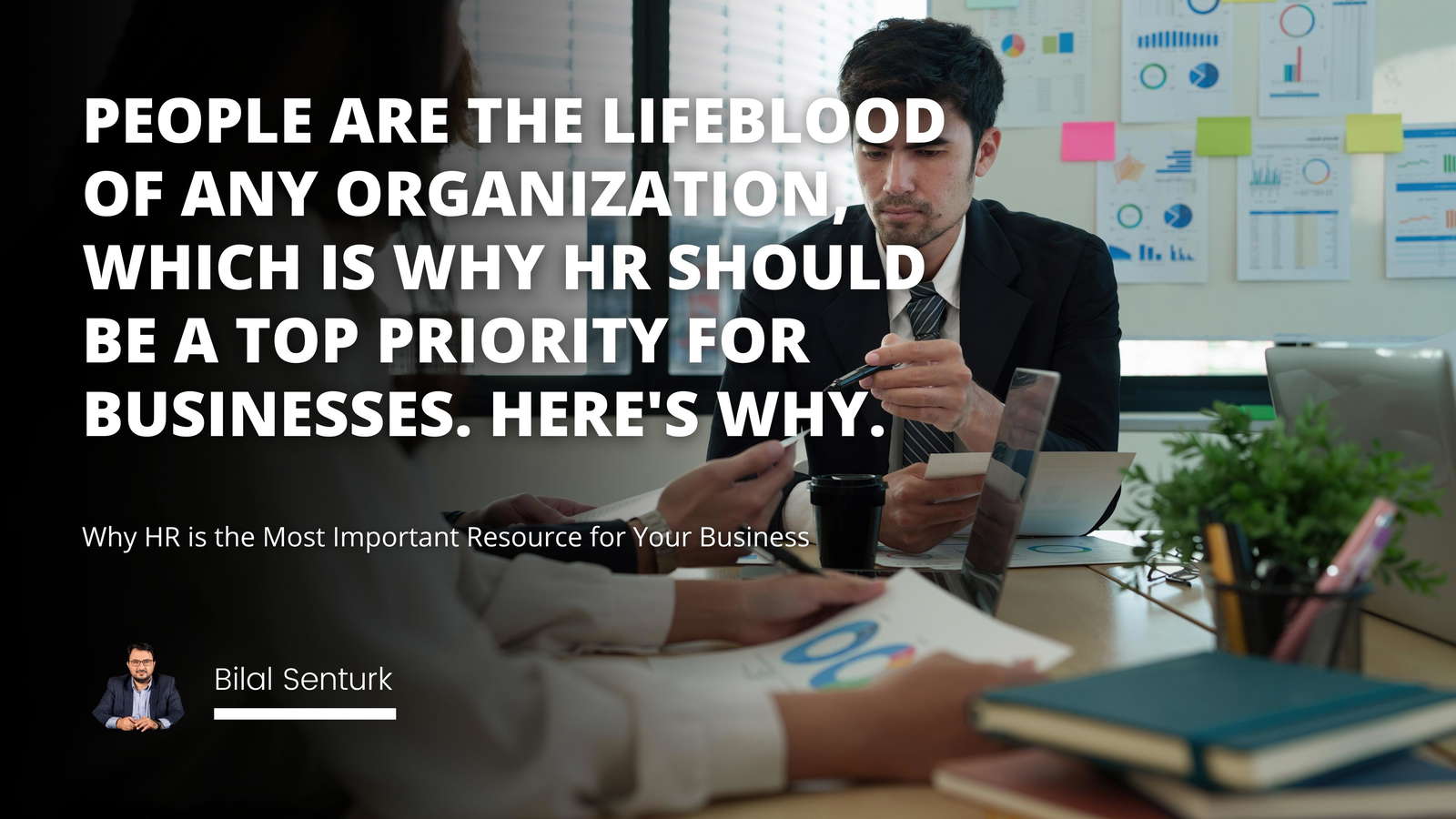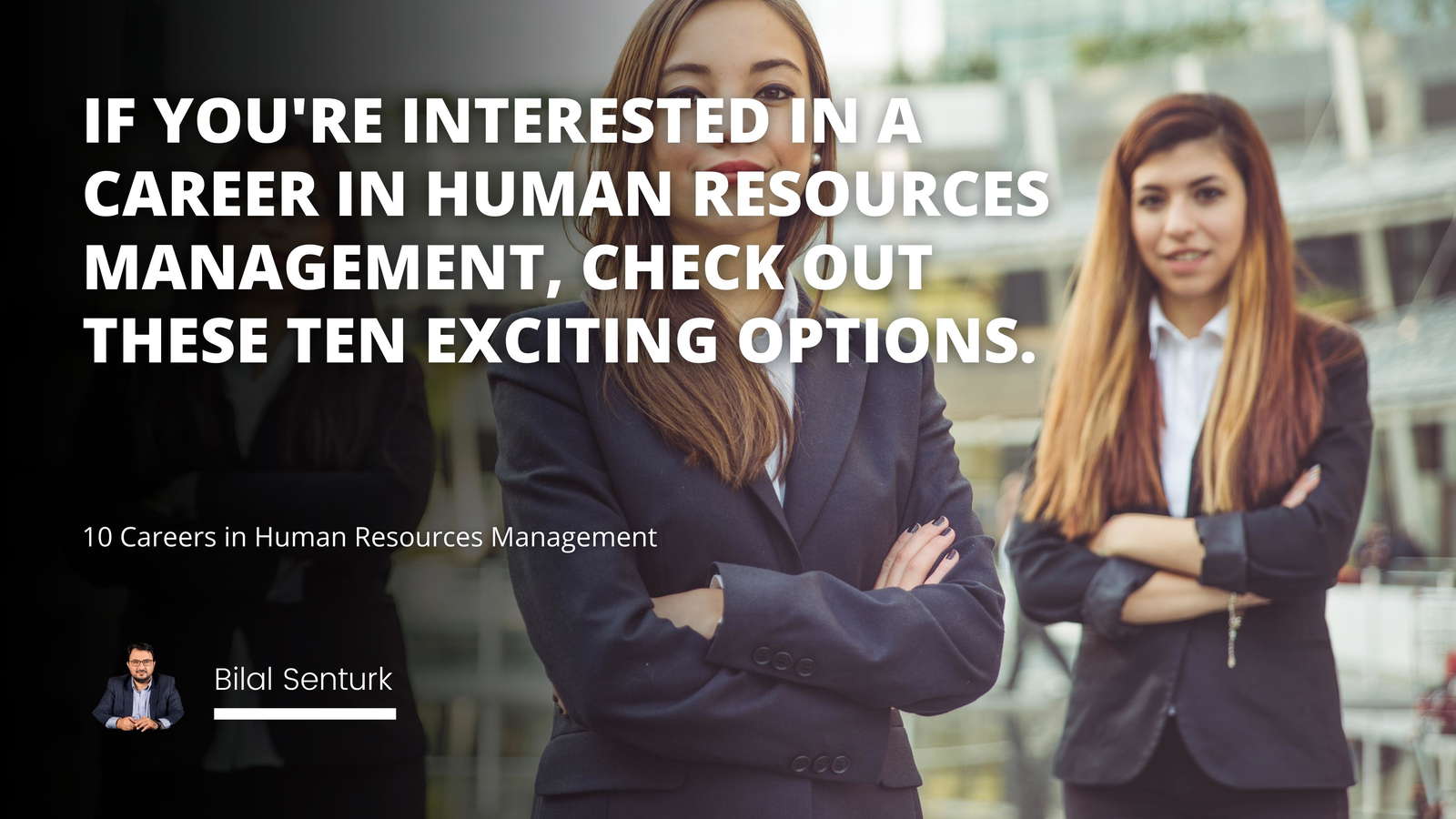
Compassion in the Workplace: The Key to Unlocking Business Success
I still remember the day when I walked into my first job at a small marketing firm. The atmosphere was electric, with everyone hustling to meet deadlines and secure new clients. However, beneath the surface, there was an undercurrent of stress and competition that often left employees feeling exhausted and unappreciated. It wasn't until a new manager joined our team that things began to change. She brought with her a simple yet profound principle: compassion.
Introduction
What Is Compassion and Why Does It Matter?
Compassion in Business
Compassion for Customers and Shareholders
Compassion about Employees
Conclusion
As someone who has witnessed the transformative power of compassion firsthand, I can attest to its importance in the workplace. When leaders prioritize empathy and understanding, it creates a ripple effect that touches every aspect of the business. Employees feel valued and supported, leading to increased job satisfaction and productivity. Customers sense the genuine care and concern, fostering loyalty and trust. Shareholders recognize the long-term benefits of a company culture built on compassion.
The Heart of Compassion in Business
At its core, compassion is the deep awareness of the suffering of others coupled with the desire to alleviate it. In the business world, this translates to recognizing the needs and concerns of all stakeholders—be it customers, shareholders, or employees—and striving to meet those needs with sincerity and empathy.
Why Compassion Matters
In an era where human resources are the most valuable asset of any organization, understanding and addressing the emotional and professional needs of individuals becomes paramount. Compassion fosters a culture where employees feel valued and heard, leading to increased job satisfaction and productivity. According to a study by Dutton et al. (2014), organizations that cultivate compassion experience improved employee performance, increased commitment, and reduced absenteeism.
Moreover, compassion has a profound impact on customer relationships. When companies demonstrate genuine concern for their customers' well-being, it builds trust and loyalty. A study by Luth and Schepker (2017) found that compassionate customer service practices lead to higher customer satisfaction and positive word-of-mouth recommendations.
Implementing Compassion in Leadership
Compassionate leadership is not just a feel-good concept; it's a strategic approach that drives business success. Leaders who prioritize empathy and understanding create a positive work environment that attracts and retains top talent.
Strategies for Compassionate Leadership
1- Active Listening: Compassionate leaders make a conscious effort to truly listen to their employees' concerns and ideas. They create an open and safe space for dialogue, encouraging employees to express themselves without fear of judgment or retribution.
2- Empathy in Decision Making: When making business decisions, compassionate leaders consider the human impact. They weigh the potential consequences on employees, customers, and the broader community, striving to find solutions that benefit all stakeholders.
3- Recognizing Achievements: Celebrating successes, both big and small, is a hallmark of compassionate leadership. Acknowledging the hard work and dedication of employees boosts morale and fosters a sense of appreciation and belonging.
In my personal experience, I once worked with a manager who exemplified compassionate leadership. She made a point to check in with each team member regularly, not just about work-related matters but also about their personal well-being. When faced with difficult decisions, she always considered the human element and sought input from those who would be most affected. Her approach created a positive and supportive work environment that inspired everyone to give their best.
Compassion in HRM is not just a matter of kindness but leadership.
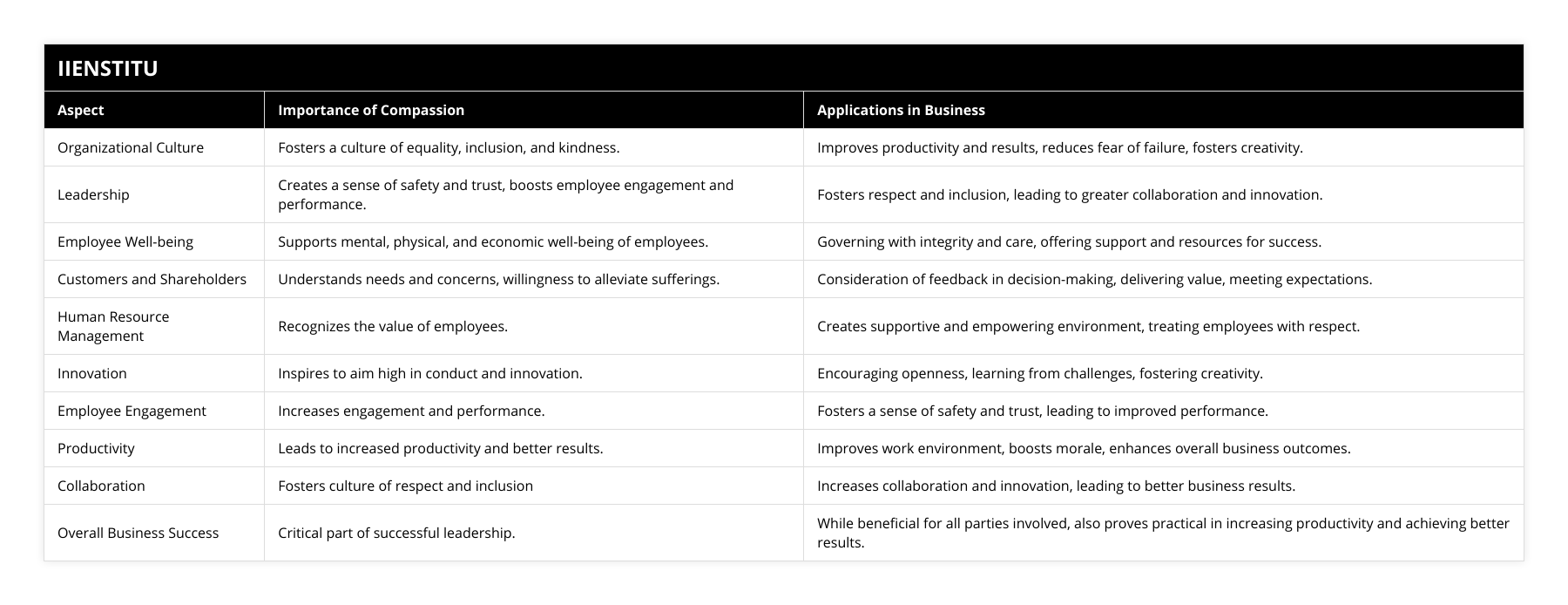
Building a Compassionate Workplace Environment
Creating a compassionate workplace requires a holistic approach that encompasses policies, practices, and daily interactions. Here are some strategies for fostering compassion in the workplace:
Open Communication Channels: Encourage employees to share their thoughts, ideas, and concerns openly. Create multiple avenues for communication, such as regular team meetings, one-on-one check-ins, and anonymous feedback mechanisms.
Professional Growth Opportunities: Invest in the development of your employees by providing training, mentorship, and opportunities for growth. Show that you care about their long-term success and are willing to support their professional aspirations.
Work-Life Balance: Recognize the importance of personal time and flexibility. Offer options such as flexible working hours, remote work arrangements, or paid time off for personal or family needs. Demonstrating respect for employees' personal lives builds trust and loyalty.
Compassionate HR Policies: Review and revise HR policies to reflect a compassionate approach. This may include generous parental leave, comprehensive health benefits, or employee assistance programs that provide support for mental health and well-being.
A study by Cameron et al. (2011) found that compassionate organizational practices, such as providing emotional support and resources during times of crisis, significantly improved employee satisfaction and commitment.
The Business Benefits of Compassion
Implementing compassion in the workplace is not just a moral imperative; it also makes good business sense. Here are some of the tangible benefits:
1- Increased Employee Retention: When employees feel valued and supported, they are less likely to leave the organization. Compassionate workplaces experience lower turnover rates, saving the company time and resources associated with recruiting and training new hires.
2- Improved Productivity: Employees who feel cared for and appreciated are more engaged and motivated to give their best effort. A study by Lilius et al. (2008) found that compassionate practices, such as providing emotional support during challenging times, led to increased employee productivity and job performance.
3- Enhanced Customer Satisfaction: Compassionate companies prioritize understanding and meeting customer needs. By actively listening to customer feedback and showing empathy in their interactions, businesses can build strong, loyal relationships with their customers.
4- Positive Brand Reputation: Companies known for their compassionate practices often enjoy a positive reputation in the market. Consumers increasingly prioritize supporting businesses that align with their values, and a reputation for compassion can attract socially conscious customers and investors.
Compassion in Action: Real-World Examples
Many successful companies have embraced compassion as a core value and have seen significant benefits as a result. Here are a few notable examples:
1- Patagonia: The outdoor clothing company is known for its commitment to environmental sustainability and employee well-being. Patagonia offers generous parental leave, subsidized childcare, and opportunities for employees to participate in environmental activism. The company's compassionate culture has contributed to its strong brand reputation and loyal customer base.
2- Salesforce: The cloud-based software company has been consistently ranked as one of the best places to work. Salesforce prioritizes employee well-being through initiatives such as mindfulness training, employee resource groups, and a focus on work-life balance. The company's compassionate approach has helped attract and retain top talent in a highly competitive industry.
3- The Container Store: The retail company is known for its commitment to employee development and well-being. The Container Store invests heavily in training and offers above-average pay and benefits to its employees. The company's compassionate culture has resulted in low turnover rates and high employee satisfaction.
Conclusion: Embracing Compassion for Business Success
In today's fast-paced and competitive business landscape, compassion may seem like a soft skill. However, the evidence is clear: compassion is a powerful tool for driving business success. By prioritizing empathy, understanding, and care for all stakeholders, companies can create a positive work environment, build strong customer relationships, and establish a reputation for social responsibility.
As leaders, it is our responsibility to model compassion in our daily interactions and decision-making processes. By embracing compassion as a core value, we can create a ripple effect that benefits our employees, customers, and the broader community.
So let us lead with compassion, knowing that it is not only the right thing to do but also the smart thing to do. By putting people first and prioritizing their well-being, we can unlock the full potential of our businesses and create a brighter future for all.
References
Cameron, K., Mora, C., Leutscher, T., & Calarco, M. (2011). Effects of positive practices on organizational effectiveness. The Journal of Applied Behavioral Science, 47(3), 266-308.
Dutton, J. E., Workman, K. M., & Hardin, A. E. (2014). Compassion at work. Annual Review of Organizational Psychology and Organizational Behavior, 1(1), 277-304.
Lilius, J. M., Worline, M. C., Maitlis, S., Kanov, J., Dutton, J. E., & Frost, P. (2008). The contours and consequences of compassion at work. Journal of Organizational Behavior, 29(2), 193-218.
Luth, M. T., & Schepker, D. J. (2017). Antecedents of corporate compassion: The role of resources, legitimacy, and institutional factors. Journal of Business Ethics, 142(1), 133-148.
Frequently Asked Questions
How to Lead with Compassion
Leadership is often associated with power, authority, and control. However, the most influential leaders are those who are compassionate and caring. This blog post will discuss the importance of leading with compassion and how to incorporate it into your leadership style.
First, let's define what it means to lead with compassion. Compassion can be defined as a sensitivity to another's suffering combined with a desire to alleviate that suffering. Leaders who lead with heart are driven to understand the needs of others and act in a way that meets those needs. They are highly attuned to their team's emotional and physical well-being and strive to create a positive and supportive environment.
Leaders who lead with compassion can create a culture of trust and respect. They can recognize their team member's strengths and weaknesses in developing their strengths. When team members feel supported, they are more likely to take risks, be creative, and collaborate effectively. This can lead to improved team performance and better outcomes for the organization.
Leaders who lead with compassion also have a more remarkable ability to motivate and inspire their team. In addition, showing genuine care and concern can create a sense of belonging and purpose, leading to higher job satisfaction and engagement.
Finally, leading with compassion can help to build strong relationships with stakeholders. Compassionate leaders can listen to and understand the needs of their stakeholders, and they are better able to build consensus and foster collaboration.
Now that we have discussed the importance of leading with compassion let's look at some practical tips for incorporating it into your leadership style.
First, focus on developing relationships. Get to know your team members and stakeholders on a personal level. Ask questions and listen actively to their needs and concerns. Show genuine interest and appreciation for their perspectives.
Second, provide a safe and supportive environment. Encourage your team to take risks and express their ideas. Celebrate their successes and provide meaningful feedback.
Third, communicate clearly and openly. Be honest and transparent in your communications. Let your team and stakeholders know what to expect and be responsive to their needs and concerns.
Finally, practice self-care. As a leader, it is essential to take care of yourself to be effective. Take time for yourself and ensure you get enough rest and exercise.
Leading with compassion is beneficial not only for your team but also for you as a leader. Compassionate leaders are often more effective and successful, as they can motivate and inspire their team, build strong relationships with stakeholders, and create an environment of trust and respect. Following the tips outlined in this blog post, you can incorporate compassion into your leadership style and become a more effective leader.

What are the benefits of incorporating compassion into HRM practices?
Compassion is essential in the workplace as it can improve the employee experience, increase morale, and foster a more productive and positive work environment. Human Resource Management (HRM) practices are commonly adopted to improve the overall quality of the workplace. Incorporating compassion into HRM practices can bring various benefits for both employers and employees.
One of the key benefits of incorporating compassion into HRM practices is improved employee satisfaction and morale. Compassionate HRM practices can help create a supportive and positive work environment in which employees feel appreciated and valued. This can lead to increased job satisfaction and improved employee morale, resulting in higher productivity and engagement levels. Furthermore, employees who are more satisfied with their jobs are less likely to leave the organization, resulting in improved retention rates.
Incorporating compassion into HRM practices can also help to foster strong relationships between employers and employees. Compassionate HRM practices can demonstrate to employees that their employer cares about their well-being and is willing to take steps to ensure their success. This can help to create a sense of trust and loyalty between employers and employees, resulting in improved communication and collaboration. Furthermore, employees with solid relationships with their employers are more likely to be engaged and motivated to achieve their goals.
Another benefit of incorporating compassion into HRM practices is improved employee well-being. Compassionate HRM practices can help ensure that employees’ physical, mental, and emotional well-being are considered. This can include providing employees access to resources such as mental health support, flexible working schedules, and other forms of support. These practices can help to reduce stress levels and promote a healthier and more productive workplace.
In conclusion, incorporating compassion into HRM practices can bring various benefits for both employers and employees. By creating a supportive and positive work environment, fostering strong relationships between employers and employees, and promoting employee well-being, compassionate HRM practices can help to improve employee satisfaction and morale, leading to higher productivity and engagement levels. Consequently, incorporating compassion into HRM practices is essential for creating a successful and productive workplace.
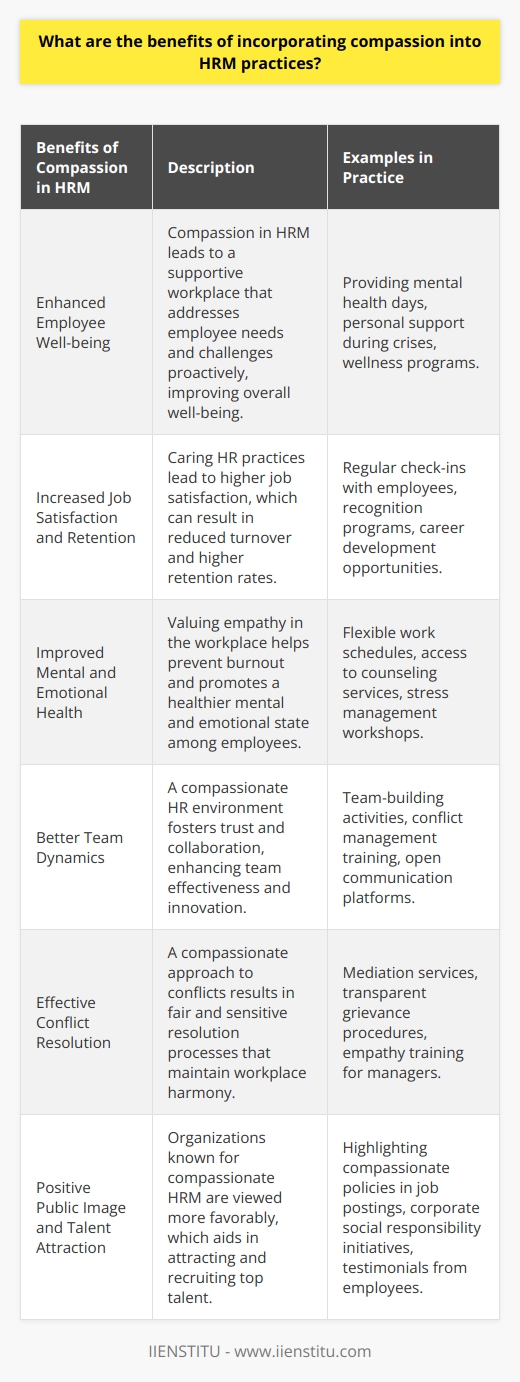
How can leaders foster a culture of compassion in the workplace?
Leaders have a unique opportunity to shape a workplace's culture and foster a culture of compassion. An emphasis on mutual respect, inclusivity, and understanding characterizes compassionate workplaces. However, to create a culture of kindness, leaders must be willing to commit to making it a priority in the workplace and take the necessary steps to ensure that all employees feel supported, respected, and safe.
When creating a compassionate workplace culture, the first step is to establish a shared understanding of what it means to be human. Next, leaders should define compassion as a concept and explain its importance to the organization's overall values and mission. This should include a clear explanation of what behaviors are expected of employees and supervisors, such as showing respect and kindness to each other and providing support and understanding to those in need.
The next step is to create a sense of community within the workplace. Leaders should encourage employees to get to know each other and form relationships on and off the job. This can be done through team-building activities, such as lunches and outings, or simply by setting aside time for employees to connect. A sense of community is essential to creating a culture of compassion, as it helps develop a sense of trust and understanding among employees.
Leaders should also foster open communication, where employees feel comfortable expressing their opinions and concerns. This can be done by creating an open-door policy where employees can ask their supervisors questions or issues. It is also essential for supervisors to actively listen to their employees and provide meaningful feedback. Doing so will help to create an environment of trust and respect, which is necessary for a compassionate workplace.
Finally, leaders should create a culture of accountability, where employees are held accountable for their actions. This can be done by establishing clear expectations and consequences for inappropriate behavior, such as bullying or harassment. Doing so will help to create an environment where employees are more likely to act with kindness and understanding towards each other.
By following these steps, leaders can foster a culture of compassion in the workplace. Doing so will help create a workplace where employees feel supported, respected, and safe and where everyone can contribute to the organization's overall success.
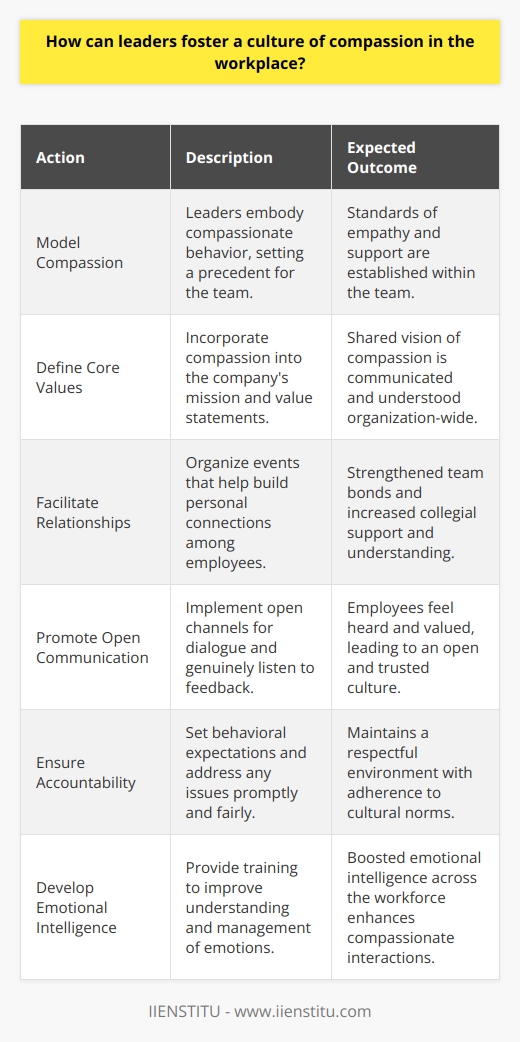
Why is it important to lead with compassion?
Compassion as a Key Leadership Trait
Leading with compassion significantly contributes to a positive organizational culture, enhanced employee satisfaction, and increased productivity. Compassionate leaders foster a supportive environment, which encourages open communication and collaboration among team members. This strengthens working relationships and improves problem-solving capabilities within an organization.
Emotional Well-being of Employees
Compassionate leadership is crucial for the emotional well-being of employees. By demonstrating empathy and understanding, leaders can help reduce workplace stress, burnout, and disengagement. In return, employees feel valued, respected, and motivated to work at their full potential. As a result, their job satisfaction increases, leading to higher levels of commitment, loyalty, and organizational success.
Socially Responsible Leadership
A compassionate leadership approach also promotes socially responsible decision-making. By prioritizing the well-being of employees and considering the broader social implications of their actions, leaders are more likely to make ethically informed decisions. This ethical approach to leadership enhances the organization's reputation and contributes to long-term sustainability.
Enhancing Organizational Performance
When leaders exhibit compassion, they create a positive environment where employees are more willing to take risks, innovate, and seek personal and professional development opportunities. Compassionate leadership cultivates trust, which enables individuals to work together without fear of repercussions. This trust-based environment promotes creativity, leading to improved organizational performance.
Fostering Inclusiveness and Diversity
A compassionate leader acknowledges and appreciates the diverse backgrounds, experiences, and perspectives of team members. This approach fosters inclusiveness and reduces workplace conflicts, ensuring that each individual feels valued and respected. Consequently, the organization benefits from the diverse perspectives and innovative thinking that arise from a collaborative work environment.
In conclusion, leading with compassion not only cultivates a positive working environment but also drives organizational success. By investing in employees' emotional well-being and fostering an inclusive culture, compassionate leaders enable their teams to work effectively, adapt to challenges, and contribute positively to the broader organizational goals.
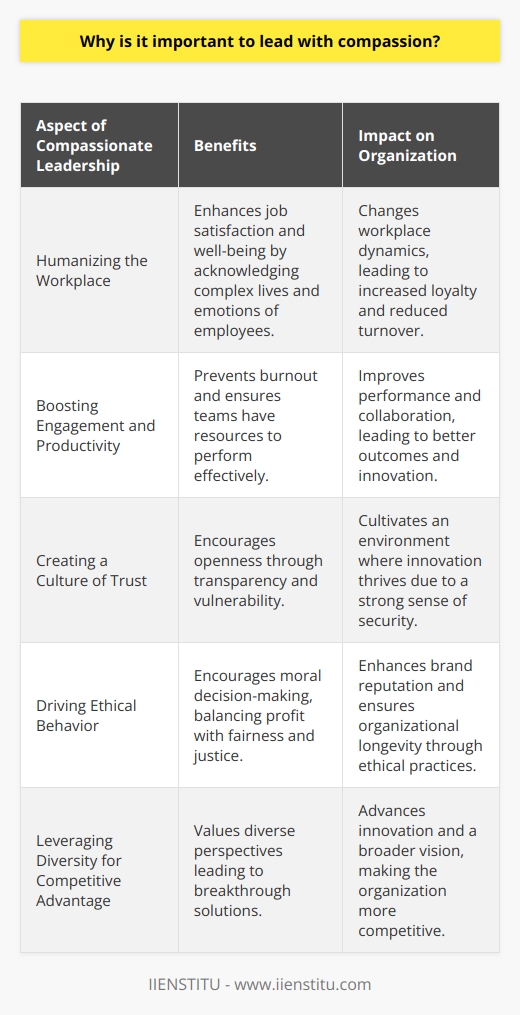
How does compassion relate to leadership?
Compassion's Role in Leadership
Compassion serves as a fundamental component of effective leadership, as it fosters empathy and understanding among team members. By displaying genuine care and concern for one's followers, a leader demonstrates a commitment to their well-being that goes beyond mere professional duty. This encourages loyalty and trust, strengthening the overall team dynamics.
Emotional Intelligence and Leadership
A compassionate leader often possesses high emotional intelligence. This enables them to recognize and comprehend the emotions and needs of subordinates, making it easier to support and guide them. Such leaders can address problems with sensitivity and tact, thus promoting a positive work culture where employees feel heard and valued.
Enhancing Decision-Making Skills
Compassionate leadership provides a foundation for ethical and morally-guided decision-making. By considering the well-being of all stakeholders, a leader cultivates an environment that takes into account the long-term implications of various choices. This holistic approach leads to more equitable and sustainable outcomes, benefitting both the organization and its constituents.
Improving Workplace Relationships
A work environment characterized by compassion enhances interpersonal relationships among team members. This climate fosters collaboration and mutual respect, which in turn leads to better teamwork. Ensuring that everyone feels valued and supported minimizes friction and contributes to a more efficient, productive work environment.
Developing Resilience and Adaptability
Compassionate leadership also promotes resilience and adaptability within an organization. This is achieved by providing subordinates with constructive feedback and encouragement, fostering a growth mindset that equips them to overcome challenges. Consequently, teams led by compassionate leaders are more capable of adapting to change and navigating obstacles successfully.
Compounding Success through Empathy
In conclusion, compassion plays a crucial role in effective leadership, as it cultivates trust, empathy, and ethical decision-making among teams. By creating a supportive and transparent work culture, leaders can drive productivity, resilience, and long-term success. This is a powerful testament to the potential impact of compassionate leadership on individuals, organizations, and society at large.
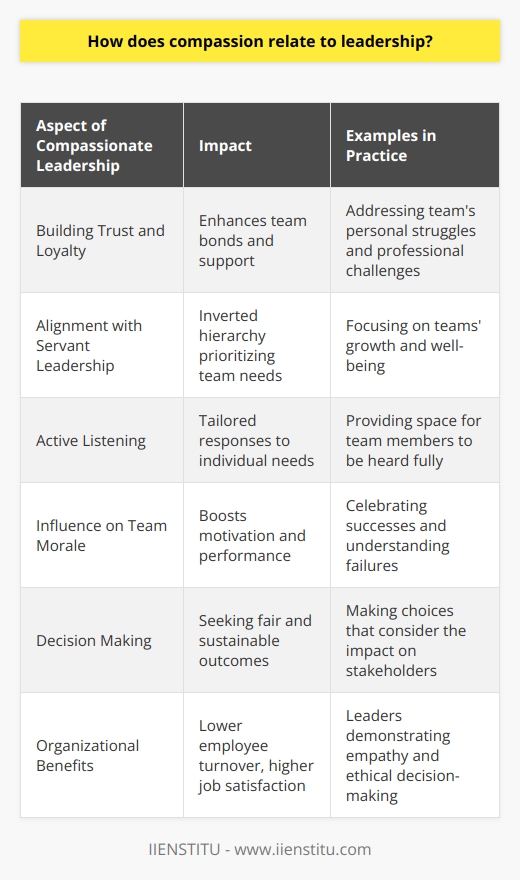
Does compassion matter in leadership?
Significance of Compassion in Leadership
Nurturing a Caring Environment
Undoubtedly, compassion holds a significant place in the realm of leadership. Leaders who display empathy and understanding towards their subordinates foster a caring and nurturing environment. This, in turn, increases employee satisfaction and promotes healthy workplace dynamics, ultimately contributing to the organization's overall productivity and success.
Enhancing Effective Communication
Compassionate leaders understand the importance of effective communication. They are attentive, mindful listeners, and offer guidance to their team members when needed. By doing so, they create an atmosphere of open dialogue, which is vital for innovation and problem-solving, as it allows for the exchange of ideas, knowledge, and feedback.
Promoting Psychological Safety
When leaders express genuine care and concern for their employees' well-being, they create a psychologically safe environment. A workplace where individuals feel supported and valued promotes self-expression, risk-taking, and collaboration. Employees in psychologically safe spaces are willing to contribute their perspectives and engage in open discussions, which leads to creative solutions and better decision-making.
Developing Stronger Teams
Compassionate leaders are conscious of their employees' personal and professional lives, acknowledging their struggles and offering necessary support. By doing so, they build trust and loyalty amongst team members, which deepens workplace relationships and leads to better teamwork. A strong team, united by trust and empathy, is a resilient force capable of overcoming challenges and achieving organizational goals.
Positive Impact on Bottom Line
Ultimately, compassionate leadership has a direct impact on the bottom line. Organizational success can be attributed to employee satisfaction, which is directly linked to compassionate leadership. When employees feel valued and cared for, they are motivated to perform at higher levels, leading to increased productivity, enhanced innovation, and reduced turnover rates.
In conclusion, compassionate leadership positively influences organizations' success by fostering a caring environment, enhancing effective communication, promoting psychological safety, developing stronger teams, and positively impacting the bottom line. Therefore, demonstrating genuine care and empathy as a leader is crucial not only for the well-being of employees but also for the overall success of any organization.

What impacts can compassionate leadership have on organizational performance?
Positive Effects on Employee Engagement
Compassionate leadership in an organization significantly impacts employee engagement by fostering a psychologically safe environment. When leaders exhibit empathy and understanding, employees feel valued and become more committed to their work. This increased engagement directly translates to higher productivity and improved overall performance.
Enhanced Communication and Collaboration
By establishing trust through compassion, leaders can break down barriers in communication and collaboration in the workplace. Open, honest, and effective communication channels create an environment that encourages problem-solving and innovation. Collaboration among teams becomes easier, leading to a more effective and efficient organization.
Reduced Employee Turnover
Employees who perceive their leaders as compassionate are more likely to continue working for the organization. Low employee turnover saves costs related to hiring and training new staff, resulting in a positive impact on the organization's financial performance. Also, a stable workforce generates greater organizational cohesion, as employees experience shared goals and visions.
Improved Organizational Reputation
Organizations that prioritize compassionate leadership projects a positive image to external stakeholders, including customers, suppliers, and investors. A company's reputation as an empathetic, values-driven employer can have a direct impact on attracting top talent, expanding its client base, and securing investment opportunities. Consequently, compassionate leadership can contribute positively to an organization's overall market position.
Increased Adaptability
In today's fast-paced business environment, adaptability is crucial for organizational success. Compassionate leaders who listen and respond to their employees' concerns can more effectively navigate changes and challenges. By recognizing and addressing the unique needs and expectations of employees, leaders who demonstrate compassion enable organizations to innovate and adapt to an evolving market landscape.
In conclusion, compassionate leadership has several positive impacts on organizational performance. By fostering a safe and supportive environment, compassionate leaders inspire employee engagement and cultivate an atmosphere conducive to collaboration, reduced turnover, and a positive reputation. Companies that prioritize compassion as a leadership trait are more likely to be adaptable and agile, setting them up for success in a constantly changing market.
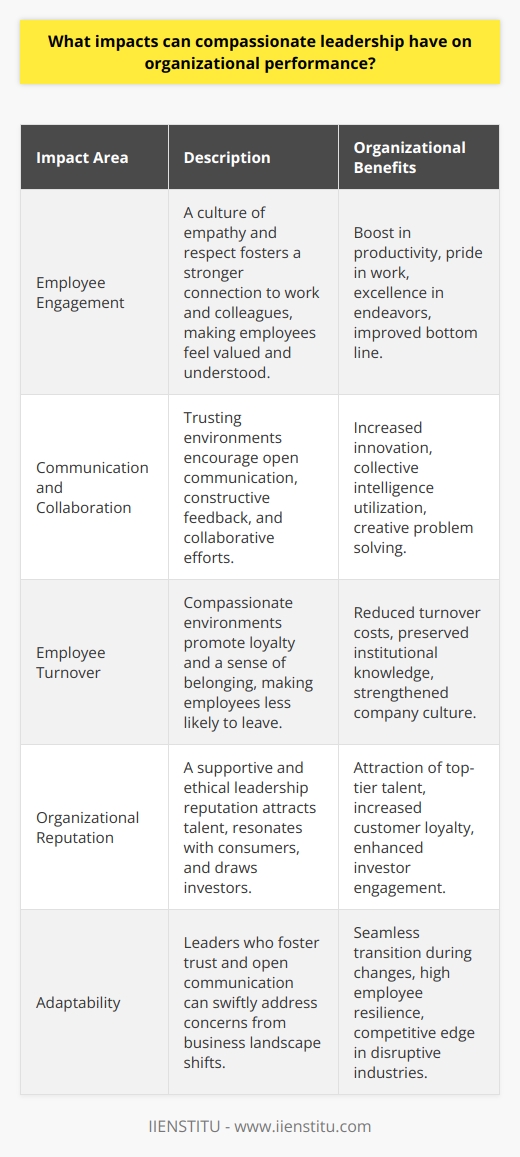
In what ways can compassion enhance a leader's decision-making abilities?
Compassion's Role in Leadership Decision-making
Compassion, a core value in the realm of leadership, represents the empathetic understanding of others' emotions and concerns. Its adoption can significantly enhance a leader's decision-making abilities in several ways.
Building Trust and Loyalty
Firstly, compassionate leaders foster a sense of trust and loyalty among team members, which is vital for effective decision-making. When employees believe that their leader genuinely cares for their well-being, they are more likely to be open and honest in communication, allowing them to collaborate and execute decisions better.
Enhancing Problem-solving Skills
A compassionate leader excels at understanding the perspectives of others, making them capable of grasping multiple dimensions of a problem. By taking into account the various opinions and emotions of team members, they can approach issues holistically, leading to more innovative and inclusive solutions. In turn, this can enhance decision-making by enabling the leader to make educated, well-rounded choices.
Promoting Collaboration and Team Cohesion
Compassionate leaders prioritize collaboration and team cohesion, key factors for effective decision-making. By cultivating an environment where diversity is celebrated, and everyone's input is valued, they facilitate better collaboration among team members. This optimizes cooperative problem-solving, enabling the group to make fully informed decisions.
Reducing Employee Turnover
Employee turnover is not only costly but also disruptive to the decision-making process. Compassionate leadership can reduce employee turnover by addressing emotional work-related problems such as stress and burnout. Leaders who prioritize employee well-being by providing resources to improve mental health ultimately cultivate a supportive work culture promoting retention. This continuity allows for more efficient and streamlined decision-making.
Encouraging Ethical Decision-making
Finally, compassionate leaders are likely to make ethical decisions rooted in empathy and moral integrity. They are more inclined to consider the long-term impact their choices may have on people and the broader environment. As a result, these decisions may be perceived as more sustainable and responsible, earning the organization a better reputation with stakeholders.
In summary, compassionate leadership can significantly enhance decision-making abilities by building trust, promoting collaboration, improving problem-solving, reducing turnover, and encouraging ethical choices. Adopting a compassionate approach can effectively create a more inclusive, harmonious, and productive work environment.
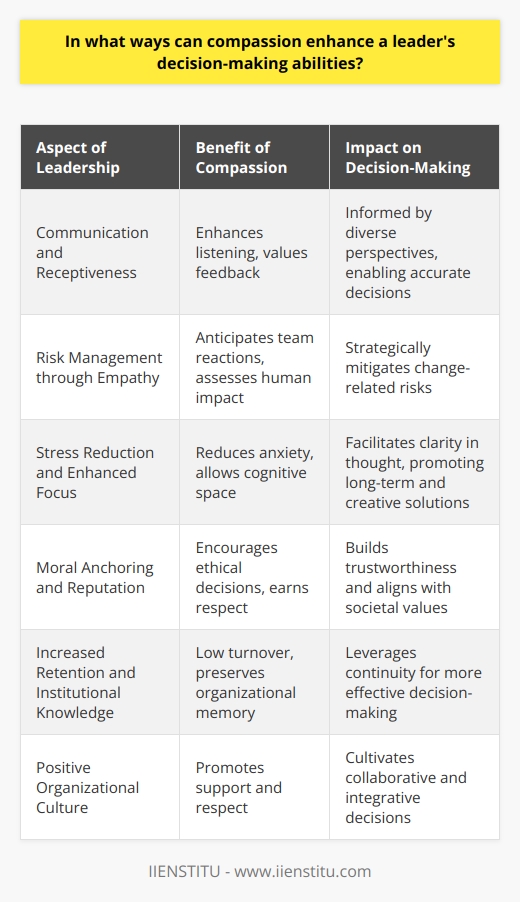
How do empathy and compassion differ within the context of leadership?
Empathy and Compassion: Key Distinctions in Leadership
Empathy and compassion are essential traits for effective leadership, but they are distinct from each other in specific aspects. Understanding the differences between empathy and compassion in leadership facilitates the development of a more nuanced and effective approach to leading others.
Role of Empathy in Leadership
Empathy refers to the ability to understand and share an individual's emotions, thoughts, and experiences. In leadership, empathy typically involves recognizing the needs, feelings, and perspectives of team members, acknowledging their concerns, and validating their emotions. Empathetic leaders create an open environment where employees feel seen and valued, leading to increased trust and loyalty.
Practical Application of Compassion
Compassion, on the other hand, goes beyond understanding and involves taking action to alleviate the suffering of others. In leadership, compassionate leaders not only empathize with their team members but also provide support, guidance, and resources to help them overcome challenges. Compassionate leaders actively seek ways to improve the well-being and happiness of their employees, acknowledging their responsibility for creating a supportive and nurturing work environment.
Balancing Empathy and Compassion
Exceptional leadership combines the strengths of both empathy and compassion. Empathetic leaders who fail to show compassion may create a superficial work environment that lacks genuine support, while overly compassionate leaders can risk overly prioritizing employees' emotions at the expense of their performance. A balanced approach involves understanding emotions, providing support, and setting boundaries to help team members grow personally and professionally.
In conclusion, while empathy and compassion are related, they possess distinct qualities with unique implications for leadership. Leaders who effectively incorporate both empathy and compassion into their leadership styles demonstrate genuine concern for their team members' well-being and growth. This balanced approach fosters a healthy work environment and ultimately drives better overall team performance.
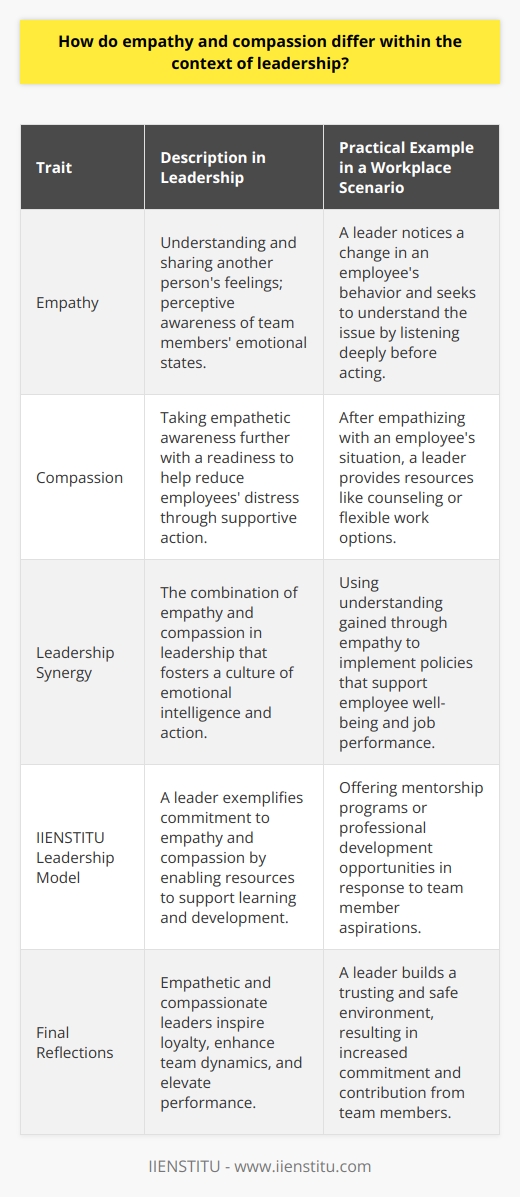
How can compassionate leadership contribute to employee well-being and satisfaction?
Role of Compassionate Leadership
Compassionate leadership is an essential factor in fostering employee well-being and satisfaction. By practicing empathy and understanding in the workplace, leaders create an environment that promotes not only the professional growth but also the personal well-being of their employees.
Emotional Support and Open Communication
Compassionate leaders are genuinely concerned about their employees' feelings and emotions. They recognize and respond to their employees' feelings and provide emotional support when needed. Open communication channels enable leaders to actively listen to their employees, provide constructive feedback, and discuss personal and professional concerns. This fosters a trusting and caring work culture, thus contributing to employee satisfaction.
Enriching Work Environment
A work environment that prioritizes individual well-being is conducive to employee satisfaction. Compassionate leaders take active steps to minimize work-related stress and encourage a reasonable work-life balance for their employees. By offering flexible work arrangements, incorporating wellness initiatives, and promoting collaboration over competition, these leaders create an enriching work environment that positively impacts employee satisfaction.
Recognition and Appreciation
Acknowledging employees' efforts and contributions is crucial for boosting their morale and satisfaction. Compassionate leaders make it a point to celebrate individual and team achievements regularly. They express gratitude and recognize exceptional work, making employees feel valued and motivated to put in their best efforts.
Investment in Employee Development
One of the hallmarks of compassionate leadership is its focus on employee development. These leaders are committed to nurturing the growth and development of their employees by investing in continued education, skill enhancement, and personal growth opportunities. Such investments help employees advance in their careers, which in turn fosters loyalty and contentment.
Inclusion and Diversity
Finally, compassionate leaders recognize the value of having a diverse and inclusive workforce. They promote equal opportunities and implement robust policies to ensure employees from different backgrounds and experiences feel supported and welcome in the workplace. In doing so, they contribute to a sense of belonging and satisfaction among their employees.
In conclusion, compassionate leadership significantly contributes to employee well-being and satisfaction by providing emotional support, fostering open communication, creating a nurturing work environment, recognizing and appreciating accomplishments, investing in employee development, and promoting inclusion and diversity. Organizations that embrace this leadership style can not only enjoy higher employee satisfaction but also retain a more engaged and dedicated workforce.
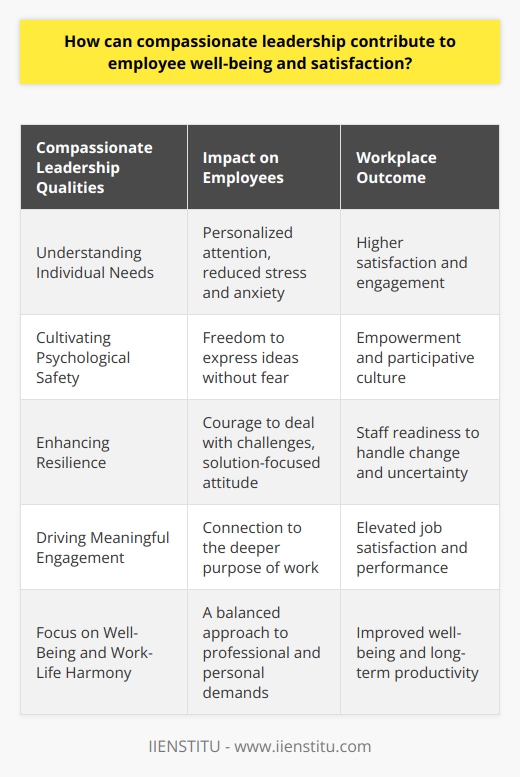
In what ways does practicing compassion in leadership help to establish trust and build strong relationships among team members?
Compassion in Leadership: Fostering Trust and Relationship Building
Compassion, as a core attribute of leadership, plays a significant role in building strong relationships and establishing trust among team members. Demonstrating empathy and understanding allows leaders to connect with their team on a deeper level, thus fostering mutual trust.
Active Listening: Building a Supportive Environment
A primary way compassion helps establish trust is through active listening. By giving team members the opportunity to voice their opinions, concerns, and ideas, leaders show that they are genuinely interested in understanding and supporting their individual needs. This open communication channel creates a sense of psychological safety, which is essential for building trust.
Empowering Others: Encouraging Personal Growth
Compassionate leaders also empower their team members by providing them with opportunities to grow both personally and professionally. By offering guidance, resources, and support, leaders demonstrate a commitment to their team's success. This investment in individual growth fosters strong relationships, as team members feel valued and understood.
Accountability and Transparency: Creating a Trustworthy Atmosphere
Accountability and transparency are essential characteristics for compassionate leaders. They acknowledge their own mistakes, learn from them, and support others in their learning process. Openly admitting mistakes and working together to find solutions fosters trust and encourages team members to do the same, creating a collaborative and supportive environment.
Recognizing and Celebrating Success: Boosting Team Morale
A compassionate leader acknowledges the hard work and success of their team members. This recognition fosters a sense of accomplishment and loyalty among team members, contributing to strong relationships, high morale, and increased trust. Celebrating successes together also nurtures a sense of belonging and unity among the team.
Responding to Conflict and Needs: Fostering Emotional Support
Compassionate leaders address conflicts and concerns proactively while showing empathy and consideration for the feelings of all involved parties. By demonstrating emotional support, leaders establish trust and create a sense of security among team members, resulting in stronger, more supportive relationships.
In sum, practicing compassion in leadership is vital in establishing trust and building strong relationships within a team. Through active listening, empowering, demonstrating accountability, celebrating success, and offering emotional support, compassionate leaders create an environment of trust and unity that fosters effective teamwork and success.

How can leaders strike a balance between compassion and assertiveness to ensure optimal performance and accountability?
Balancing Compassion and Assertiveness
Leaders play a crucial role in influencing employees' performance and reinforcing accountability within organizations. To ensure optimal outcomes, leaders must strike a balance between compassion and assertiveness. Navigating this balance involves understanding employees' perspectives, promoting mutual respect, and setting clear expectations.
Understanding Employees' Perspectives
A compassionate leader invests time in understanding their employees' experiences, challenges, and aspirations. This awareness enables leaders to make informed decisions and empower employees, fostering a supportive work environment. Furthermore, by validating employees' emotions and concerns, leaders build trust and commitment, essential for organizational success.
Promoting Mutual Respect
Mutual respect enables leaders to maintain their assertiveness without causing resentment among employees. By treating employees with respect, leaders encourage open communication, constructive feedback, and collaborative decision-making. This inclusive approach facilitates informed decision-making and higher quality of work, driving collective success for the organization.
Setting Clear Expectations
With the foundation of trust and respect established, leaders can move to set clear expectations for employees. These expectations should be reasonable, attainable, and aligned with organizational goals. By being assertive about desired outcomes, leaders can hold employees accountable for their performance. When employees understand their roles and responsibilities, they feel empowered and motivated to meet, and often exceed, these expectations.
Adapting Leadership Styles
Effective leaders recognize the need to adapt their leadership styles to various contexts and circumstances, including the needs and personalities of their employees. Sometimes, being compassionate may require offering assistance or allowing for flexibility, while at other times, assertiveness may necessitate taking difficult decisions, like withholding promotions or terminating employees. Understanding the context and adapting accordingly will ensure leaders maintain the right balance between compassion and assertiveness.
Conclusion
In conclusion, a balanced approach between compassion and assertiveness is essential for leaders to ensure optimal performance and accountability in employees. Achieving this equilibrium demands understanding employees' perspectives, promoting mutual respect, setting clear expectations, and adapting leadership styles to suit different scenarios. Ultimately, compassionate and assertive leadership contributes to a thriving, collaborative, and successful work environment.
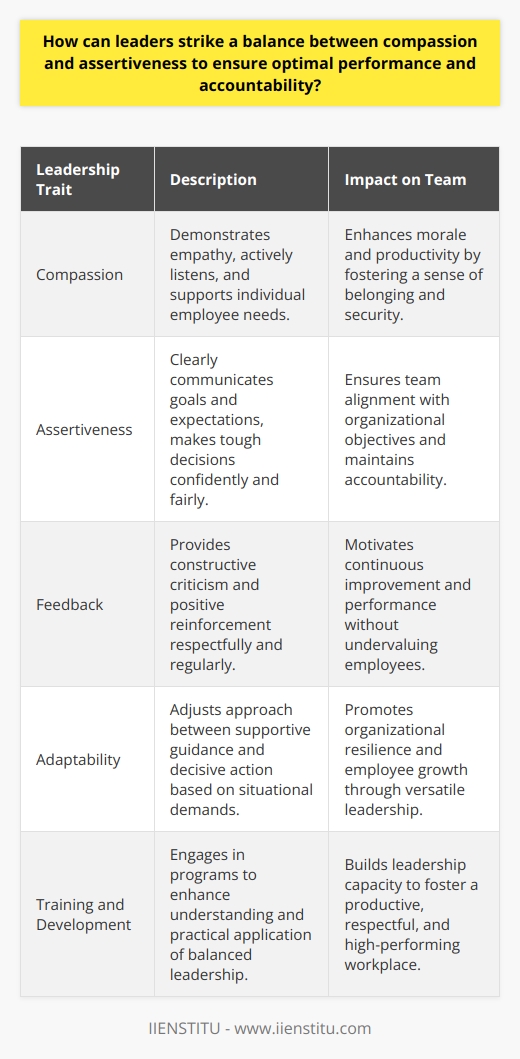
Why is compassion important in the workplace?
Compassion as a Key Driver
Compassion is essential in the workplace as it fosters a positive work environment, contributes to employee well-being, and enhances overall productivity. Amidst increasingly competitive and fast-paced work scenarios, the need for understanding, empathy, and a supportive atmosphere cannot be understated.
Strengthening Employee Relations
One reason compassion is important in the workplace is that it helps create a sense of interpersonal connection, which is essential for establishing strong employee relations. By showing empathy and understanding towards colleagues, individuals can build trust and rapport with one another, creating a harmonious working environment. When employees feel supported and connected, it translates to higher collaboration and teamwork, ultimately contributing to business success.
Promoting Mental Health and Well-being
Moreover, compassion in the workplace plays a critical role in promoting mental health and well-being. An empathetic manager or supervisor can help alleviate stress and anxiety among employees by providing a safe space for discussing work-related problems and concerns. This flexible and supportive approach can lead to reduced burnout rates and increased job satisfaction, contributing to employees' overall mental health.
Improving Conflict Resolution
Having compassion in the workplace is also crucial for effective conflict resolution. By approaching disagreements and disputes with empathy, employees can better understand their colleagues' perspectives and find solutions that address everyone's needs. Furthermore, a compassionate work environment promotes open communication and discourages the establishment of a blame culture, which can enhance problem-solving and conflict resolution capabilities.
Boosting Employee Motivation and Productivity
Lastly, compassionate workplaces tend to have higher levels of employee motivation and productivity. When employees feel understood and respected by their superiors and peers, they are more likely to be engaged and committed to their work, resulting in better performance and increased output. By fostering an organizational culture that values compassion, businesses can experience long-term productivity gains and employee satisfaction.
In conclusion, cultivating a compassionate work environment is essential for businesses aiming to foster strong employee relations, promote mental well-being, and enhance productivity. Ensuring that empathy and understanding are valued and demonstrated by all members of the organization is a critical step towards creating a supportive, collaborative, and harmonious workplace that benefits both employees and the business as a whole.
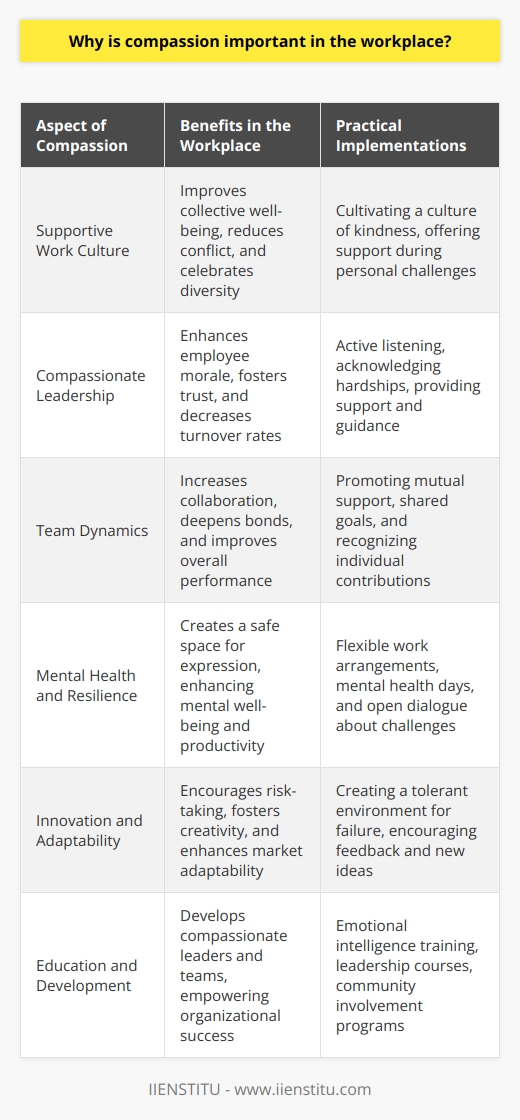
How can compassionate leadership improve employee engagement and productivity?
Compassionate Leadership and Employee Engagement
Compassionate leadership plays a crucial role in fostering employee engagement and productivity. When leaders exhibit empathy, understanding, and genuine care towards their team members, it establishes a positive workplace environment that contributes to increased employee satisfaction and motivation. Furthermore, compassionate leaders are more likely to prioritize the emotional well-being of their staff, resulting in reduced burnout and increased job retention.
Encouragement and Support
When leaders encourage and support their employees, it instills a sense of belonging and purpose within the team. This social connection enables team members to feel valued and appreciated, leading to heightened engagement and commitment to their work. Moreover, the provision of appropriate guidance and resources by compassionate leaders facilitates employees in their professional growth and development, promoting self-confidence and ultimately enhancing productivity.
Recognition and Feedback
Another aspect of compassionate leadership is providing consistent, constructive feedback and recognizing individual accomplishments. By acknowledging employees' contributions, leaders not only strengthen their relationships with team members but also incentivize continued high-quality work. This positive reinforcement serves to reinforce a mindset of continuous improvement among employees, fostering a more proactive, goal-oriented, and productive team culture.
Emotional Intelligence
A key attribute of compassionate leadership is emotional intelligence, which involves understanding and managing emotions – both of their team members and their own. By exercising empathy and actively listening to employees' concerns and needs, leaders can help create a psychologically safe work environment. This sense of security enables employees to openly share ideas, take calculated risks, and collaborate more effectively, ultimately leading to increased innovation and productivity.
Balancing Professionalism and Compassion
While it is essential for leaders to exercise compassion, striking a balance between professionalism and compassion is crucial. Compassionate leaders should maintain clear expectations and standards for their team members, holding them accountable for their responsibilities. However, they should also be willing to provide assistance and support when necessary. This balanced approach facilitates both high-quality output and employee satisfaction, ensuring a mutually beneficial work environment.
In conclusion, compassionate leadership contributes to improved employee engagement and productivity by establishing an inclusive, supportive, and psychologically safe work environment. By understanding the emotional needs of their team members, empathizing with their struggles, and providing appropriate support, compassionate leaders can foster a workplace culture that encourages growth, innovation, and success.
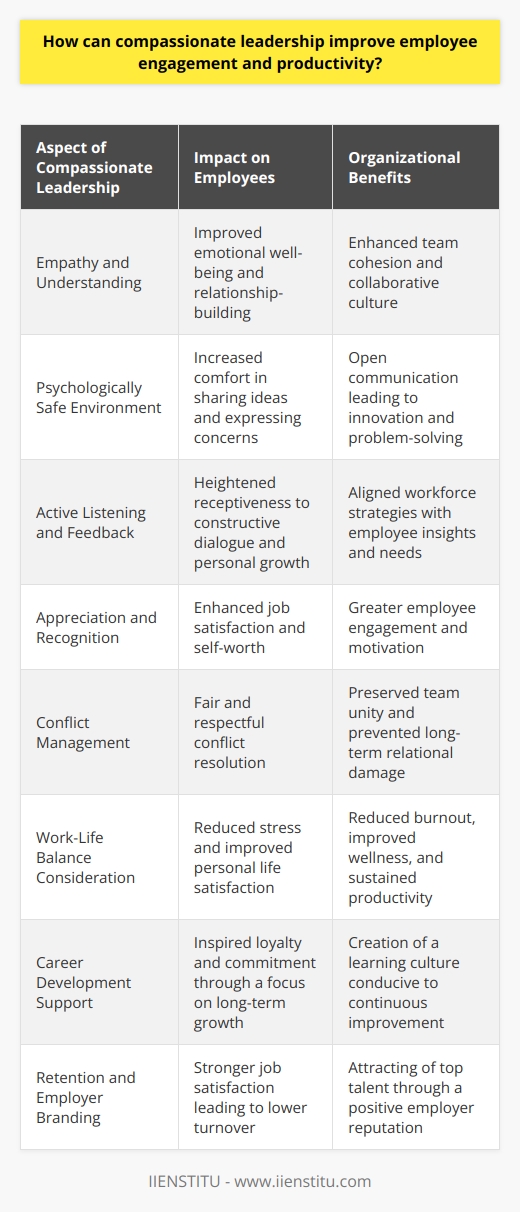
In what ways can a compassionate approach to management lead to reduced workplace stress and increased employee retention?
Compassionate Management and Workplace Stress Reduction
A compassionate approach to management can significantly reduce workplace stress and increase employee retention in various ways. Firstly, creating a supportive and understanding work environment encourages open communication. Employees feel more comfortable discussing their concerns or challenges, enabling management to address the issues promptly and effectively. Consequently, this fosters a sense of belonging, improving workers' mental and emotional wellbeing.
Employee Empowerment through Compassionate Leadership
Emphasizing empathy in management practices promotes employees' emotional and mental needs. By treating employees as individuals and taking the time to understand their unique circumstances, compassionate managers empower their workforce. This approach allows employees to develop their full potential, thereby reducing work-related stress and fostering job satisfaction.
Positive Work-Life Balance
Supporting a work-life balance demonstrates a compassionate managerial approach. Encouraging employees to prioritize their personal lives and wellbeing might reduce work-induced stress significantly. By endorsing flexible schedules, providing time off for family or personal matters, and understanding that employees have lives outside work, managers can alleviate workplace anxiety while maintaining productivity.
Workplace Wellness Programs
Implementing comprehensive wellness programs contributes to a compassionate managerial approach. These programs encompass physical, mental, and emotional wellbeing initiatives that educate employees, promoting self-care strategies, and providing access to support services. A holistic wellness plan can help workers manage stress more effectively, increasing job satisfaction, and reducing burnout.
Recognition and Appreciation
A compassionate approach to management involves recognizing employee achievements and expressing appreciation. By acknowledging workers' efforts and celebrating successes, managers cultivate a positive workplace culture. This recognition contributes to higher job satisfaction, lower stress levels, and ultimately increased employee retention.
Collaborative Work Environment
Promoting a collaborative work environment reinforces compassion in management. Encouraging teamwork, sharing responsibilities, and fostering an inclusive atmosphere empowers employees and nurtures a supportive culture. When employees feel valued and included, stress levels decrease, and job contentment increases, resulting in higher employee retention rates.
In conclusion, a compassionate approach to management can measurably reduce workplace stress and increase employee retention. By fostering open communication, empowering employees, supporting work-life balance, implementing wellness programs, recognizing achievements, and promoting collaboration, managers actively demonstrate compassion. This approach benefits both employees and the organization as a whole, creating a positive, productive, and effective work environment.
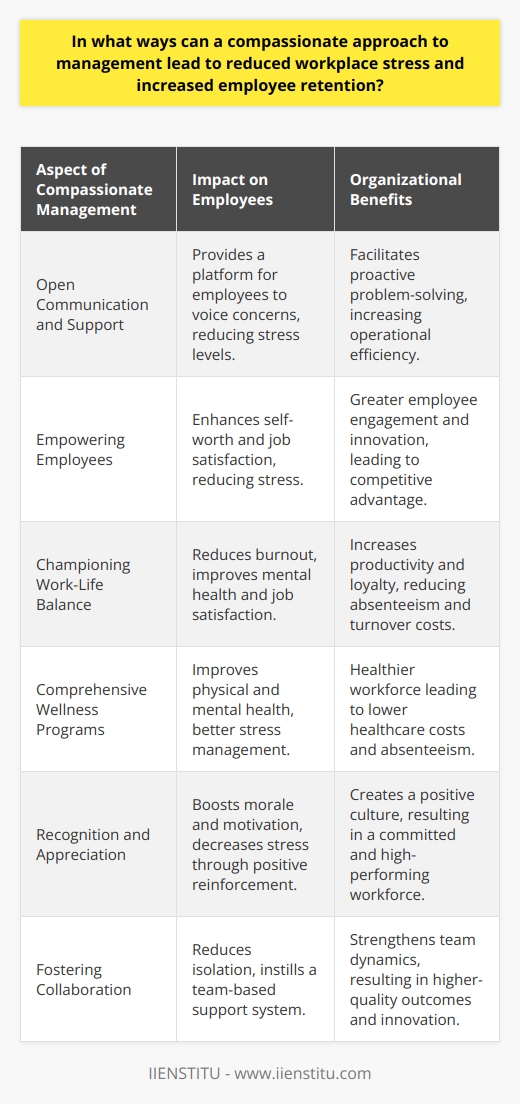
Why is it important to lead with compassion in diverse and inclusive work environments?
Compassion's Role in Diverse and Inclusive Work Environments
Understanding Diverse Perspectives
Leading with compassion in diverse and inclusive work environments is crucial to establish harmonious relationships and foster collaboration among team members. By empathizing with individuals who hold different backgrounds, beliefs, and cultural practices, a compassionate leader can bridge gaps in understanding and communication.
Enhancing Team Dynamics
A compassionate approach also contributes to improved team dynamics, as leaders can better identify the unique strengths and potential weaknesses of each team member. Consequently, assigning tasks and responsibilities becomes more efficient, harnessing the diversity present in the workplace and ensuring the team operates at an optimal level.
Promoting Inclusiveness
Compassionate leadership promotes inclusiveness by encouraging open dialogues and creating a safe environment for employees to express their thoughts and emotions. Through actively listening and addressing concerns, a leader can prevent misunderstandings and make all employees feel valued and included, regardless of their personal characteristics or backgrounds.
Mitigating Conflict
Conflict is inevitable in diverse work settings, as people view situations through various lenses stemming from their experiences and identities. Leading with compassion equips leaders to navigate conflicts effectively, facilitating resolution through empathy, open communication, and understanding. By adopting a compassionate lens, leaders can create an environment conducive to collective growth and productivity.
Boosting Employee Well-being
Finally, compassion in leadership plays a vital role in supporting employee well-being. A work environment where employees feel understood, accepted, and valued fosters a sense of belonging and reduces stress levels. Moreover, the psychological safety provided under compassionate leadership encourages employees to take risks, be innovative, and openly share their ideas, generating positive impacts on both individual and organizational performance.
In conclusion, compassionate leadership is essential in diverse and inclusive work environments to foster understanding, improve team dynamics, create inclusiveness, mitigate conflict, and boost employee well-being. As the modern workplace continues to evolve, a leader’s ability to empathize with, value, and support individuals of diverse backgrounds will strongly contribute to overall success.
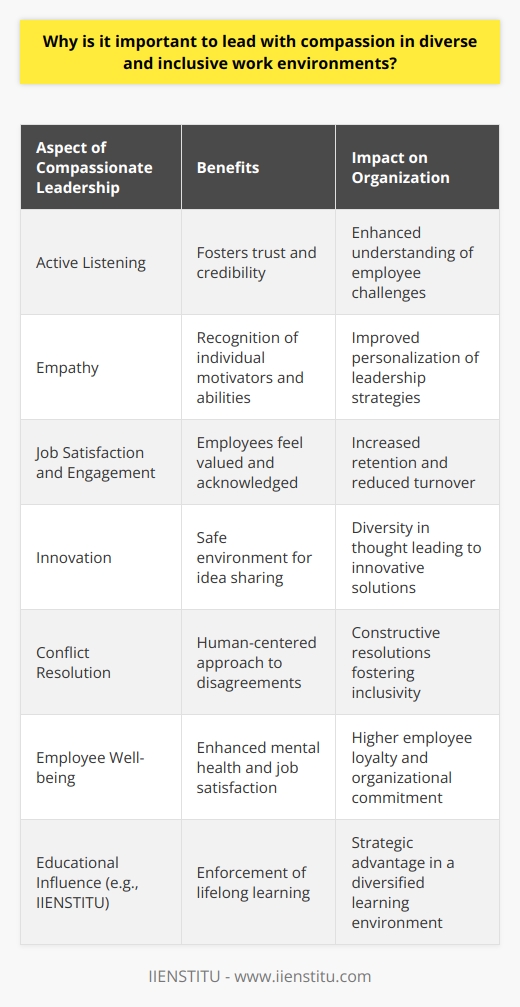
How can leaders effectively demonstrate compassion while maintaining professional boundaries and avoiding favoritism?
Balancing Compassion and Professionalism
Leaders can effectively display compassion in the workplace while maintaining professional boundaries and avoiding favoritism by adopting certain strategies and fostering a culture of empathy. These methods ensure that employees feel supported and fairly treated, contributing to a positive working environment.
Clear Communication of Expectations
Establishing well-defined expectations and guidelines about professional conduct helps to outline the distinction between compassionate leadership and favoritism. By transparently communicating standards and ensuring everyone is aware of the rules, leaders can make more consistent decisions, leaving less room for perceptions of unfairness.
Creating a Supportive Environment
Fostering a compassionate work culture involves creating an environment where employees are encouraged to share their thoughts, feelings, and concerns. This approach allows leaders to understand the challenges faced by individual employees and provide targeted support. By attending to the needs of all employees rather than a select few, leaders can minimize potential for favoritism.
Active Listening and Empathy
When leaders actively listen to their employees and empathize with their concerns, they demonstrate compassion while reinforcing professional boundaries. By understanding each employee's situation and responding thoughtfully, leaders can provide valuable support without displaying preferential treatment. Moreover, practicing empathy positions them to be more objective and sensitive to issues of fairness.
Adopting a Solution-Oriented Approach
Addressing issues and concerns in a constructive and solution-oriented manner can encourage a fair work environment. Leaders should work collaboratively with employees to develop and implement practical and equitable resolutions. This process can help mitigate feelings of favoritism and maintain professional boundaries.
Consistent and Fair Treatment
Ensuring consistent and fair treatment of all employees helps to establish compassionate leadership while avoiding favoritism. By treating everyone based on merit and avoiding personal biases, leaders can create a work culture that values empathy, fairness, and objectivity.
Reinforcing Boundaries for Favoritism
Lastly, leaders need to be proactive in addressing any perceptions of favoritism by soliciting feedback from employees and making adjustments when necessary. Taking responsibility and addressing these concerns head-on can help to build trust and restore confidence in their leadership.
In conclusion, leaders can demonstrate compassion while maintaining professionalism and avoiding favoritism by practicing effective communication, fostering a supportive environment, active listening, employing a solution-oriented approach, and treating all employees consistently and fairly. By doing so, they not only establish trust and fairness in the workplace, but also foster positive and productive work environments.
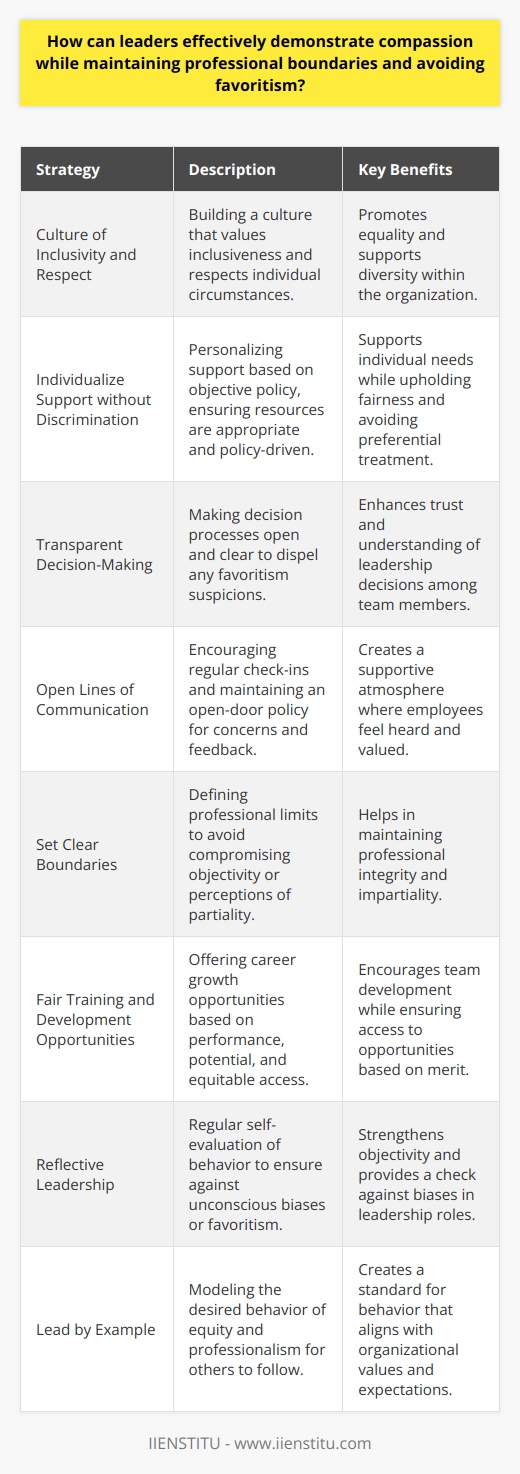
In what ways does compassionate leadership support innovation and creative problem-solving in the workplace?
Compassionate Leadership and Innovation
Compassionate leadership positively influences innovation and creative problem-solving in the workplace in several ways. Firstly, it creates a safe environment for employees to take risks and experiment with new ideas. When leaders express empathy and understanding, employees feel supported and are more likely to step outside their comfort zones to explore innovative solutions.
Emotional Intelligence and Collaboration
Another critical aspect of compassionate leadership is emotional intelligence, which enables leaders to better understand and manage their own emotions and those of their colleagues. High emotional intelligence promotes open communication, allowing employees to express their ideas and opinions without fear of repercussions. This open dialogue fosters collaboration, which is crucial for creative problem-solving and innovation. When employees from diverse backgrounds and areas of expertise work together, they generate fresh insights and innovative solutions.
Empowering Employees and Encouraging Growth
Compassionate leaders are also focused on empowering their employees and encouraging personal and professional growth. They recognize the potential in each individual and offer support and resources to help them develop their skills and abilities. This investment in employee development not only contributes to an organization's overall success but also helps to cultivate a culture of continuous learning and improvement. As employees grow and adapt, they are better equipped to generate innovative ideas and tackle complex problems.
Leadership By Example
Finally, compassionate leaders inspire innovation by modeling the behaviors they want to see in their employees. They demonstrate their commitment to creativity and problem-solving by being open to new ideas and seeking input from others. By showing that they are willing to be innovative themselves, compassionate leaders give employees the confidence to pursue their own creative solutions.
In conclusion, compassionate leadership supports innovation and creative problem-solving in the workplace by creating a safe and open environment, promoting collaboration through emotional intelligence, empowering employees to grow and develop, and leading by example. By fostering these conditions, organizations can unlock the full potential of their employees to drive impactful change and long-term success.
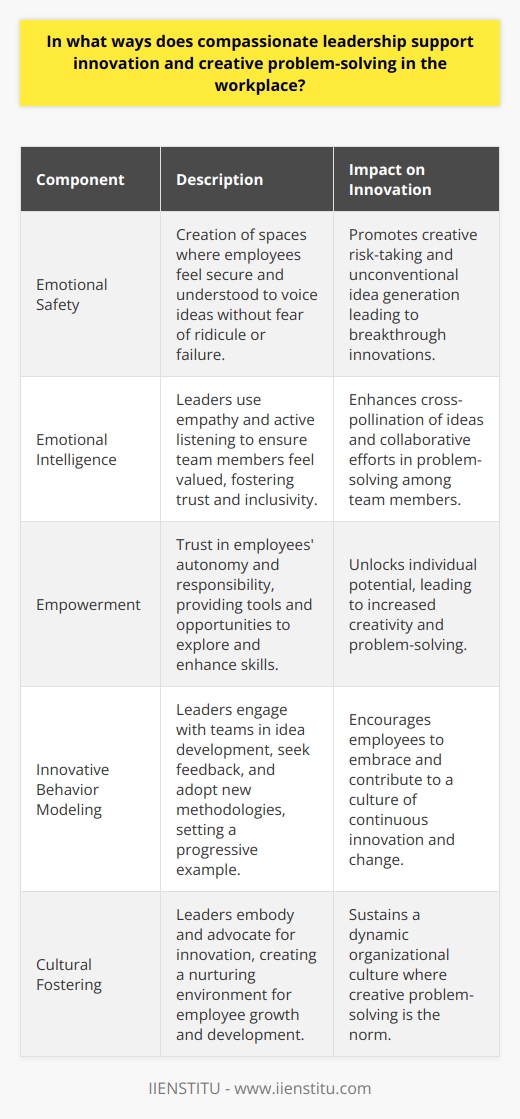
What is the relationship between compassion and emotional intelligence in the context of leadership?
Understanding Compassion and Emotional Intelligence
Compassion and emotional intelligence are mutually inclusive in effective leadership. They form fundamental good leadership qualities. Compassion embodies concern and empathy for others, while emotional intelligence involves understanding and managing one's emotions while dealing with others.
Compassion in Leadership
A compassionate leader shows understanding and empathy toward their team members. This quality enables them to foster stronger relationships, build trust, and promote a positive working environment. Compassion often results in increased morale amongst team members, as they perceive their leader to care about their wellbeing.
Emotional Intelligence in Leadership
Leaders possessing high emotional intelligence are skilled in recognizing their own, as well as others' emotions. Such leaders can manage their feelings, thereby responding to situations appropriately. Superior emotional intelligence can result in improved decision-making, conflict resolution, and communication within a team.
Interplay Between Compassion and Emotional Intelligence
Both compassion and emotional intelligence are interconnected. With a high level of emotional intelligence, leaders can better understand and share the feelings of others That is, strong emotional intelligence often facilitates compassion. Simultaneously, having compassion can boost one's emotional intelligence by developing a greater understanding of others' emotional states.
Concluding Thoughts
In the context of leadership, compassion and emotional intelligence are very crucial for successful leadership. They drive motivation, improve productivity, and create healthier work environments. Thus, they are not separate qualities, but rather integral, interlinked components of effective leadership.
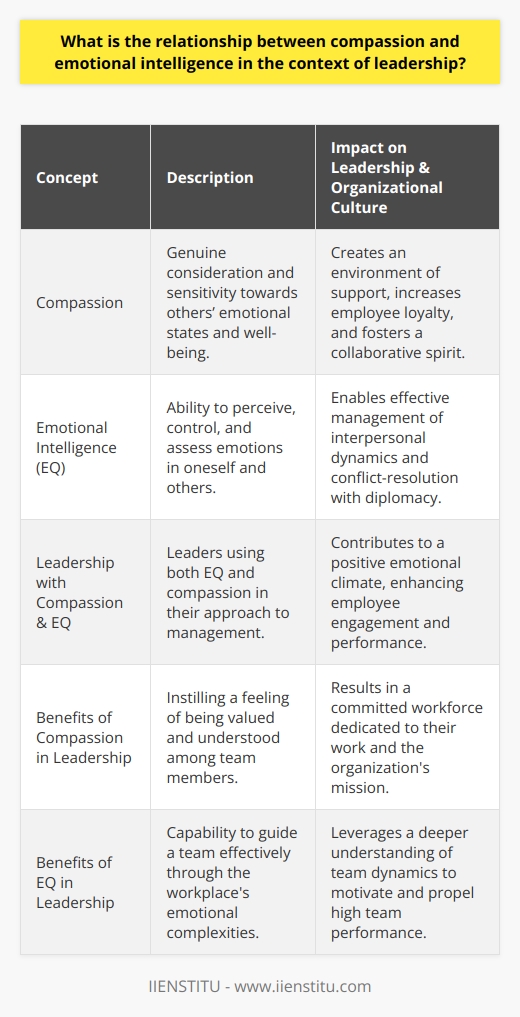
How does compassionate leadership impact team dynamics and conflict resolution?
Compassionate Leadership and Team Dynamics
Compassionate leadership vastly alters the dynamics within a team. It encourages open and honest communication. Regular dialogue minimizes misunderstandings and breeds trust among team members. A compassionate leader fosters an environment of mutual respect which subsequently curtails unproductive conflicts.
Impact on Conflict Resolution
Moreover, compassionate leadership significantly influences the conflict resolution process. During conflict, a compassionate leader takes time to understand the perspectives of all parties involved. This approach helps to unearth the root cause of the issue and facilitate a mutually satisfying resolution. When a leader shows empathy, it strengthens relationships and reduces recurrence of similar conflicts.
Inspiration and Motivation
A compassionate leader also inspires and motivates team members. They offer support during challenging times, leading to increased team cohesiveness. The demonstration of genuine concern for team members' welfare encourages them to go the extra mile. This boost in morale leads to an overall enhancement in team performance.
Promoting Innovation
Further, compassionate leadership promotes innovation within teams. The leaders’ willingness to accept mistakes as a part of the learning process paves the way for creativity. It allows for the free exchange of ideas and cultivates a culture of learning and innovation. Therefore, compassionate leadership enhances team dynamics and assists in effective conflict resolution, creating a conducive environment for high performance.
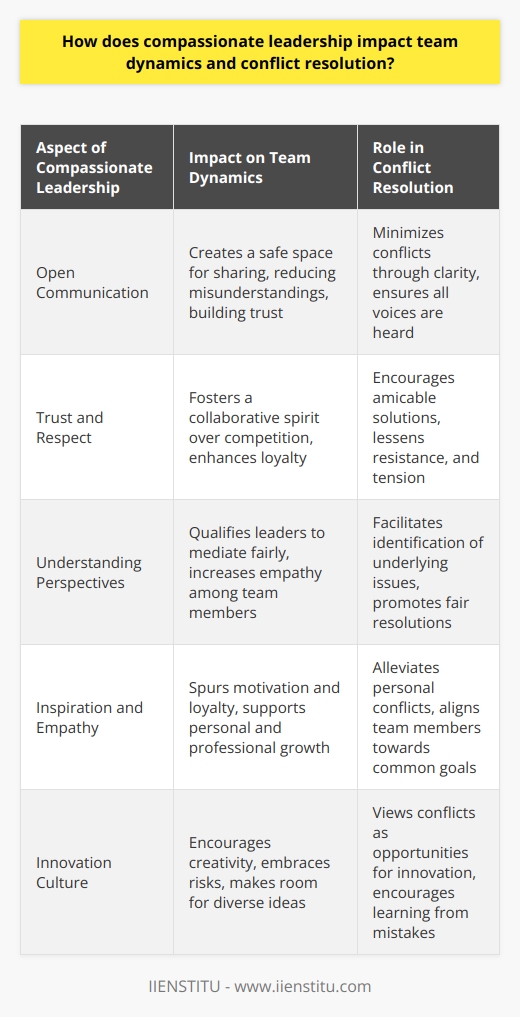
What are the key elements to successfully integrating compassion into various leadership styles?
Understanding Emotional States
A fundamental element for integrating compassion into leadership styles pertains to understanding and empathy. Leaders must recognize the emotional states of their team members. They must positively respond to their needs and concerns, fostering an environment where individuals feel valued.
Effective Communication
Effective communication significantly influences compassionate leadership. Leaders should listen actively and respond with empathy. Through this, the leader conveys understanding and concern for the team's emotional well-being.
Promotion of Shared Vision
Promoting a shared vision is key to compassionate leadership. Leaders who establish common goals foster unity and collaboration. This, in turn, creates a supportive working environment.
Appreciation and Recognition
Appreciating and recognizing the contributions of team members plays a significant role in compassionate leadership. With recognition, leaders can drive motivation and boost morale. This develops a sense of value and belonging among the team.
Openness to Feedback
A leader's openness to feedback is critical in compassionate leadership. This openness encourages a two-way communication process. It helps to build trust and improve relationships within the team.
Building Trust
Trust is a key element in integrating compassion into leadership styles. By being consistent, truthful, and transparent, leaders build trust. Trust cultivates a positive and harmonious team environment.
Balancing Empathy and Decision Making
Leaders must strike a balance between empathy and decision-making. Even while demonstrating compassion, leaders must make rational business decisions. Balancing these aspects ensures the achievement of organizational goals while maintaining interpersonal relationships.
Through understanding emotional states, effective communication, promoting shared vision, appreciation, openness to feedback, building trust, and balancing empathy with decision-making, leaders can successfully integrate compassion into their leadership styles.
